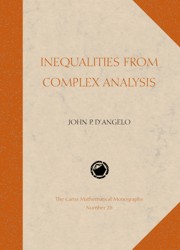Book contents
- Frontmatter
- Contents
- Preface
- I Complex Numbers
- II Complex Euclidean Spaces and Hilbert Spaces
- III Complex Analysis in Several Variables
- IV Linear Transformations and Positivity Conditions
- V Compact and Integral Operators
- VI Positivity Conditions for Real-valued Functions
- VII Stabilization and Applications
- VIII Afterword
- Appendix A
- Bibliography
- Index
V - Compact and Integral Operators
- Frontmatter
- Contents
- Preface
- I Complex Numbers
- II Complex Euclidean Spaces and Hilbert Spaces
- III Complex Analysis in Several Variables
- IV Linear Transformations and Positivity Conditions
- V Compact and Integral Operators
- VI Positivity Conditions for Real-valued Functions
- VII Stabilization and Applications
- VIII Afterword
- Appendix A
- Bibliography
- Index
Summary
This chapter discusses compact operators in detail. Section 1 concerns convergence properties for sequences of bounded operators. We introduce compact operators in Section 2. The main result of the chapter is the spectral theorem for compact Hermitian operators. We provide additional discussion about integral operators, and we close the chapter with a glimpse at singular integral operators. This chapter prepares us for the applications in Chapter VII, where we use facts about compact operators to study positivity conditions for polynomials.
Convergence properties for bounded linear transformations
Completeness of the real number system is crucial for doing analysis; without it limits would be a useless concept. Similarly, completeness for metric spaces (such as Hilbert and Banach spaces) is needed for doing analysis in more general settings. We therefore begin this chapter with a short discussion of three possible notions for convergence of sequences of bounded linear transformations between Hilbert spaces.
We write L(H,H′) for the vector space of bounded linear transformations between Hilbert spaces H and H′. We mentioned in Section II.1 that L(H,H′) is a Banach space; in particular this space is complete. See Theorem V.1.4.
We next consider three reasonable definitions of convergence in L(H,H′).
Definition V.1.1. (Notions of convergence for bounded linear transformations) Let {Ln} be a sequence in L(H,H′), let L ∈ L(H,H′).
1) {Ln} converges to L in norm if the sequence of real numbers ∥ Ln − L ∥ converges to 0.
2) {Ln} converges to L in the strong operator topology if, for all z ∈ H the sequence {Ln(z)} converges to L(z) in H′.
[…]
Information
- Type
- Chapter
- Information
- Inequalities from Complex Analysis , pp. 143 - 174Publisher: Mathematical Association of AmericaPrint publication year: 2002
